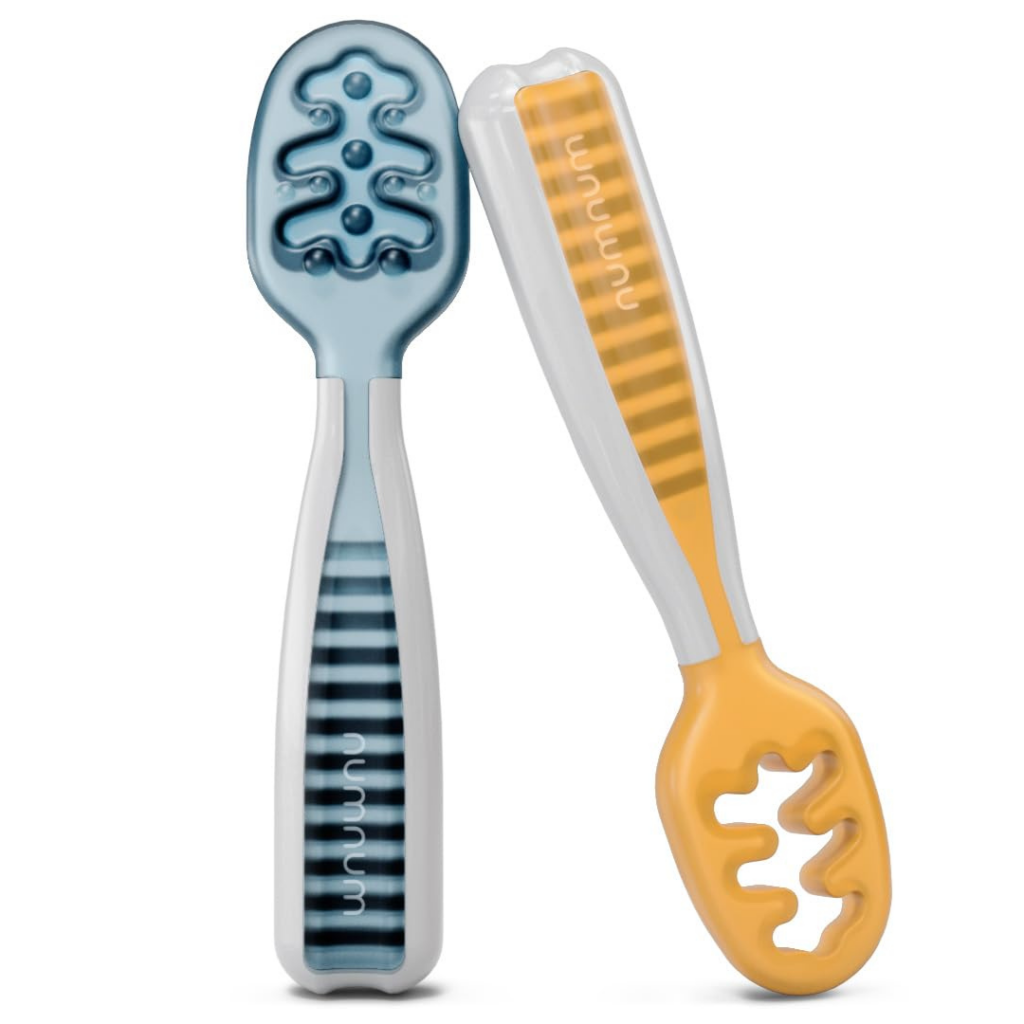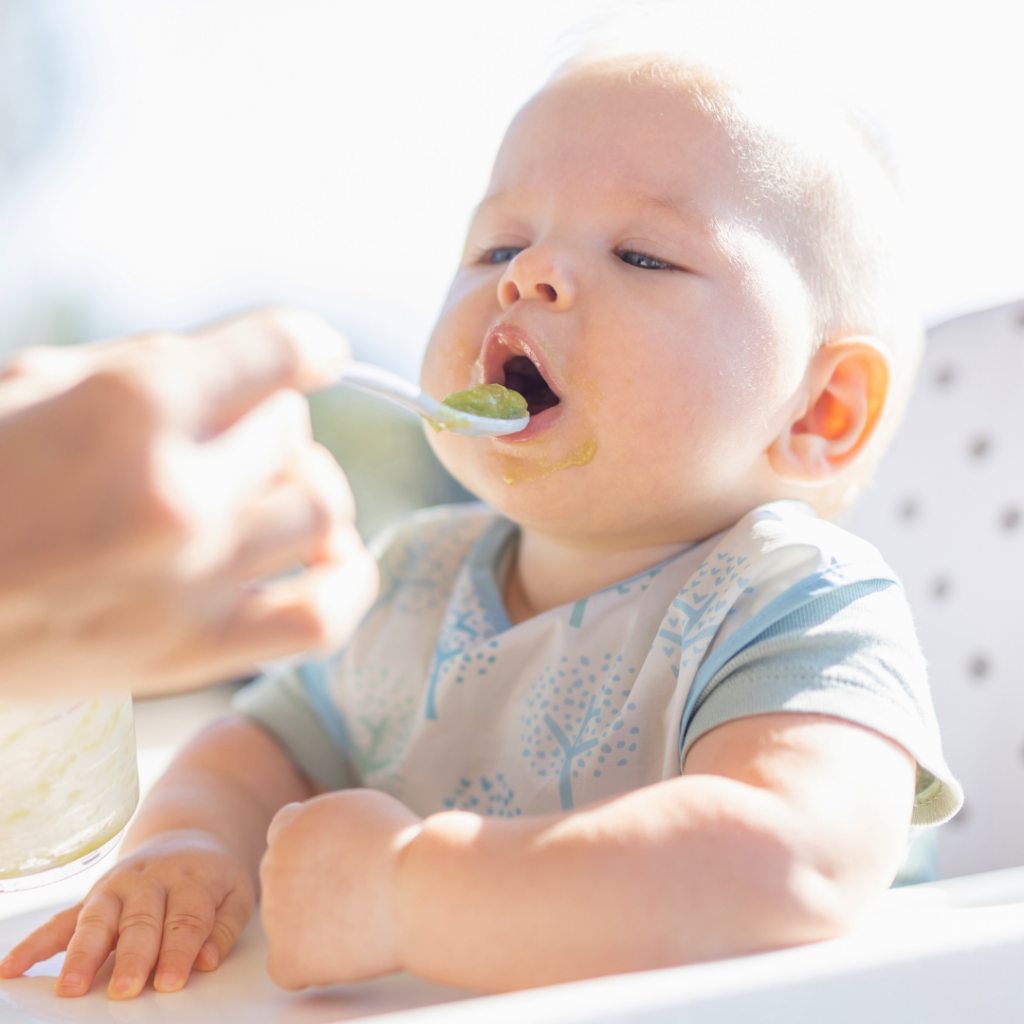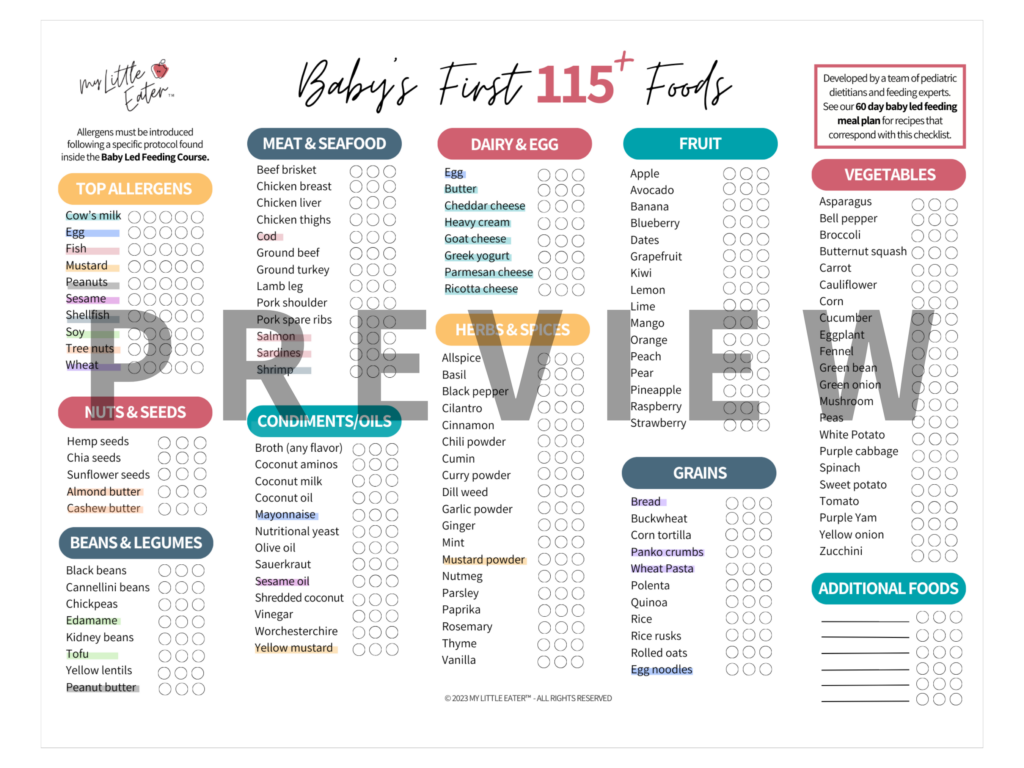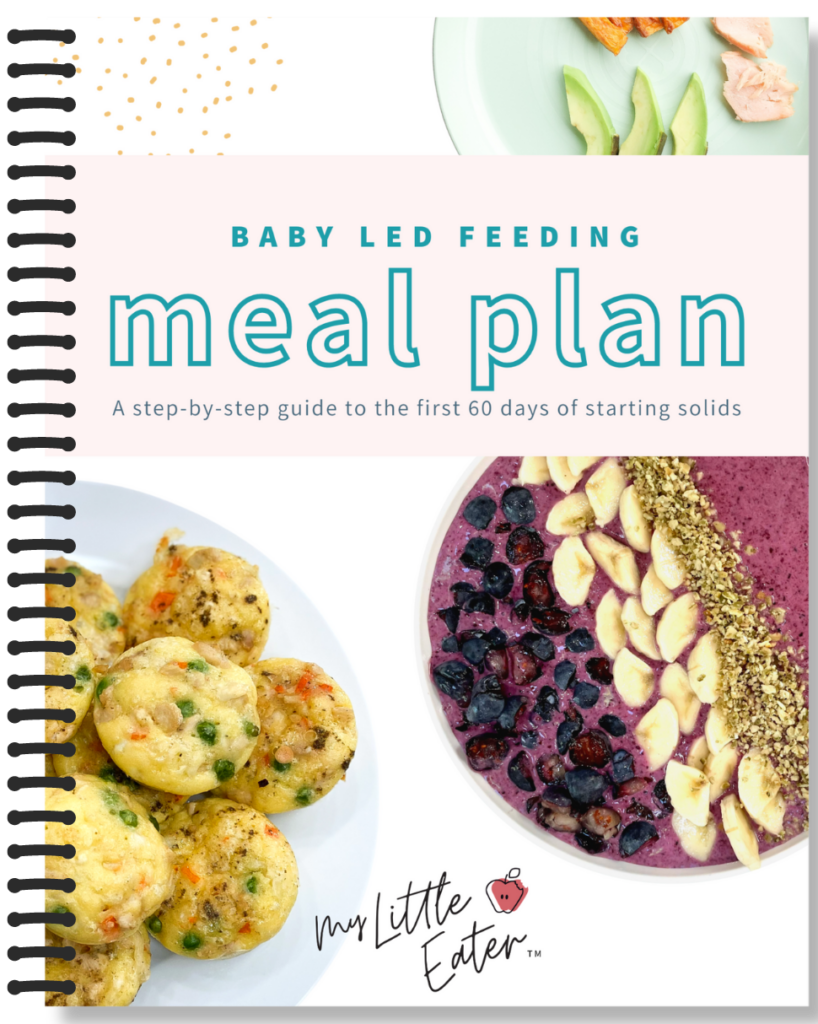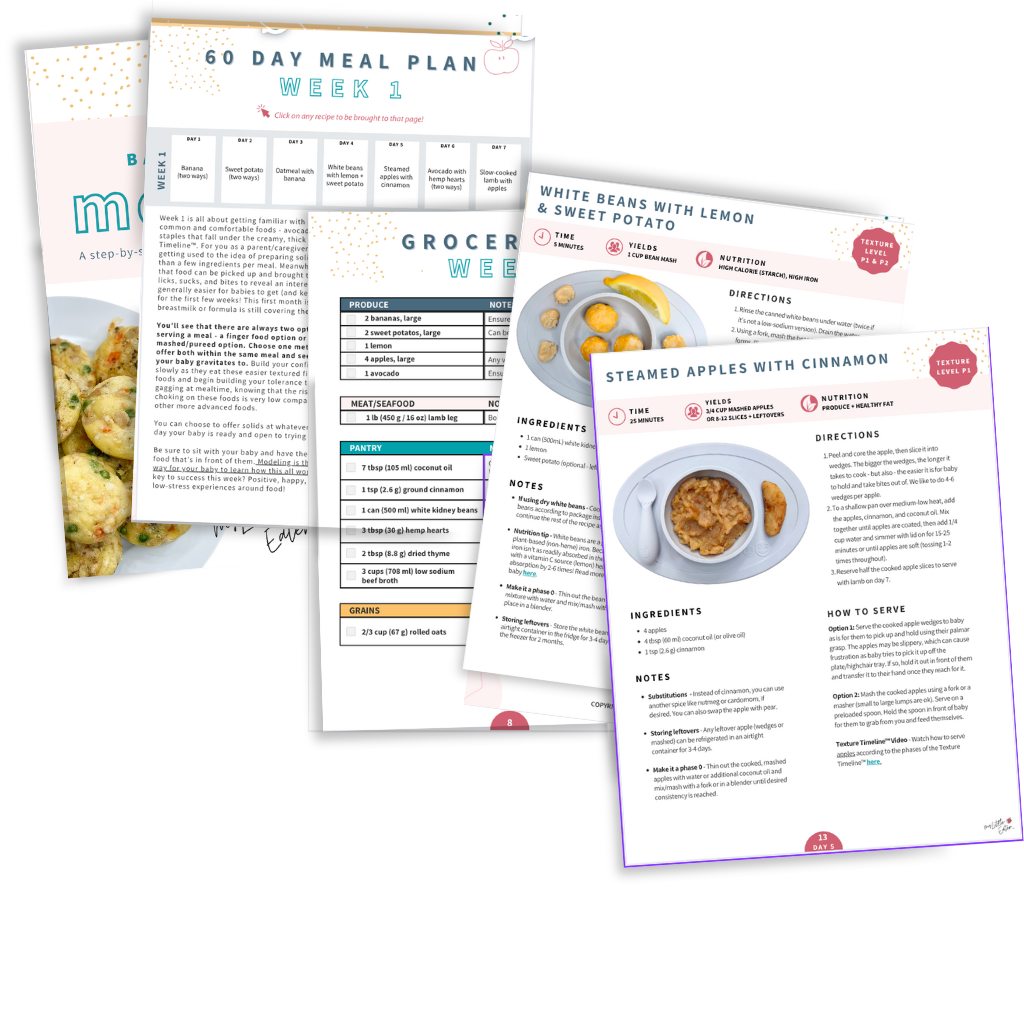- No Comments
- Edwena Kennedy, RD
This post may contain affiliate links, please view our disclosure policy for more details.
Introducing solids with purees is where most parents like to start their baby’s feeding journey. And while feeding your baby purees sounds simple enough – the truth is – there’s more to it than blending up some peas and calling it a day.
There’s actually a right and a wrong way to spoon-feed to promote healthy eating habits. There’s also a lot to know about the best spoon to use when feeding your baby their first foods. And of course, everyone wants to know how to make pureed foods at home and which types of purees are best to start with.
From choosing the right spoon to knowing when to start and how to read your baby’s cues — every piece plays a part. As a pediatric dietitian and mom of two, I’m breaking down everything you need to know to offer purees in a way that’s smart, safe, and developmentally supportive.
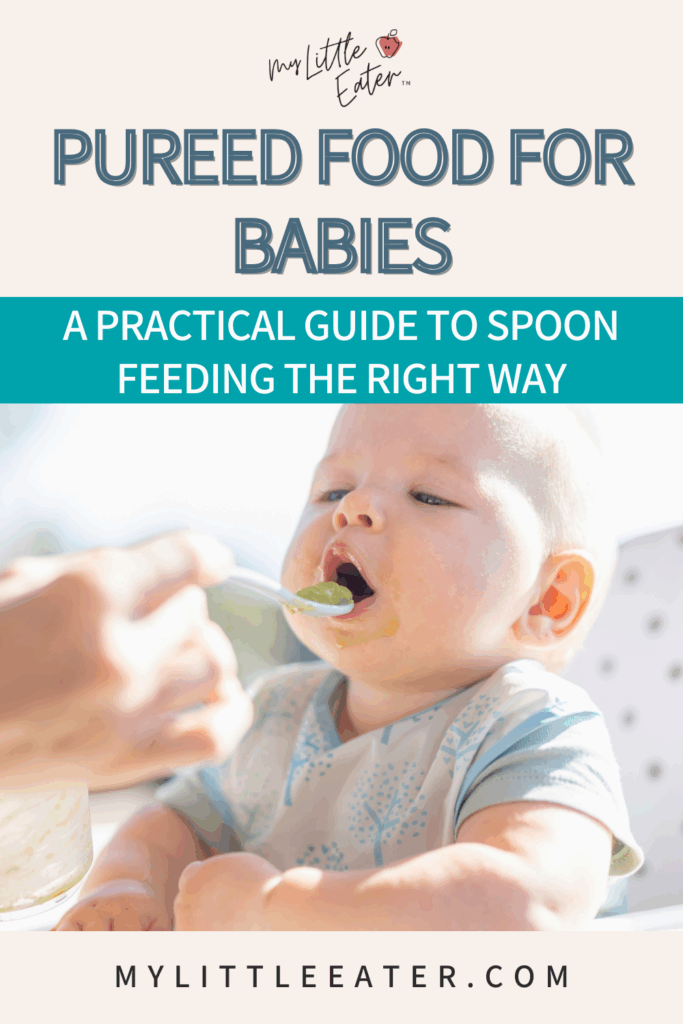
If you prefer to listen while you multitask – download our podcast episode below to hear all the details!
If you’re feeling overwhelmed about starting solids and you’re not sure where to begin, join our FREE workshop – How to start solids: A realistic first week of feeding your baby. This workshop is for parents ready to feel confident and prepared to start solids—without all the guesswork.
Learn exactly what to feed, when to feed it, and how to do it—step-by-step—with expert guidance from pediatric dietitian, Edwena Kennedy. Plus, get a FREE 5 day meal plan just for attending!

Table of Contents
What is pureed baby food?
Pureed food is any food that’s been blended, mashed, or strained into a soft, smooth consistency. It’s spoonable, easy to swallow, and often thinned with breastmilk, formula, or water. For babies starting solids, pureed food is the bridge between breastmilk or formula and more textured table foods — especially for families not jumping straight into baby-led weaning.
Examples of pureed foods are:
Mashed banana
Blended chicken mixed with broth
Infant rice cereal
Applesauce
Some foods are naturally exist as a puree (i.e. yogurt), while others are mechanically made into a puree for the purpose of feeding baby (like carrots blended with a liquid in a food processor).
Should You Start Pureed Food at 4 Months?
You might still hear advice floating around that suggests introducing purees at 4 months, and then transitioning to finger foods at 6 months. This was common guidance in the past, but it’s now outdated for most babies.
Here’s what we now know:
The readiness signs to starting solids — whether it’s purees or finger foods — are based on developmental milestones, not age alone.
What’s changed?
Current recommendations from trusted health organizations like the World Health Organization, Health Canada, and the American Academy of Pediatrics suggest introducing complementary foods around 6 months — once your baby shows specific signs of readiness. This is true regardless of whether you’re starting with spoon-fed pureed food or baby-led weaning with soft finger foods.
Why not start at 4 months?
At 4 months, most babies simply aren’t developmentally ready for solids. They typically lack:
Stable head and neck control
Core strength to sit upright unassisted
A diminished tongue-thrust reflex
The coordination to move food safely from the front to the back of their mouth
Introducing solid foods — including pureed food — too early can increase the risk of choking and digestive issues, and may displace the breast milk or formula they still rely on for full nutrition.

Why start with purees as the first solid food?
While it’s not necessary to start your baby on pureed food (you can start with finger foods and follow baby led weaning principles) – many parents like to ease into first foods with purees. Starting with pureed food ensures:
An easy bridge from the breast milk or formula they’re used to
A texture that’s not too difficult to chew or swallow
A low choking risk
An easier time quantifying how much food baby eats
May be easier to consume more calories or iron in the early days
At My Little Eater, we are big proponents on starting solids with whatever feeding method you feel most comfortable with – whether that be with purees or finger foods. All we ask is that you advance your baby in a timely manner from easier to more advanced textures as they show they’ve mastered a previous texture.
We’ve created our proprietary Texture Timeline™ framework for just this reason! It shows you how to progress from phase 0 meals (think pureed fruit), to phase 1 meals (think of thick, creamy mashed avocado), to phase 2 meals (think lumpy flaked fish in a bit of yogurt), to phase 3 meals like meat on it’s own (and beyond)! Following our framework will ensure you are expanding your baby’s oral motor skills and preventing picky eating down the road. Learn more here.
How to feed purees the right way
Feeding your baby pureed food isn’t just about getting calories in. It’s a chance to build lifelong eating habits, support oral motor development, and create a positive relationship with food from the very first bite.
The key? Responsive feeding.
What Is Responsive Feeding?
Responsive feeding means paying close attention to your baby’s hunger and fullness cues — and letting those cues guide the feeding experience. It’s about trusting your baby to know how much to eat, instead of trying to control it.
Even if that feels a little scary, you’re not alone. But here’s the reassuring part: babies are born knowing how to eat intuitively. Think about how they’ve been nursing or taking bottles on demand. Feeding other foods works the same way — they lead, you follow.
Why This Matters with Pureed Food
When you tune in and respond to your baby’s cues while feeding pureed food, a few powerful things happen:
They build self-awareness around hunger and fullness
They enjoy mealtimes and feel more in control
They’re less likely to overeat or undereat
They learn to trust food and their own bodies
This approach helps prevent power struggles and emotional eating later in life.
What cues should parents be responding to?
Every baby is different so cues can vary depending on your little one’s unique personality (6). In general, there are some common things to look out for at meal time when it comes to recognizing your baby’s cues. Let’s review them!
Hunger cues
Signs that your baby is hungry and would like to continue eating their meal include (7):
- Opening their mouth wide
Leaning in toward food
Following food with their eyes
Excitedly waving arms or kicking legs
Smacking or licking lips
Suckling
Putting their hand to their mouth
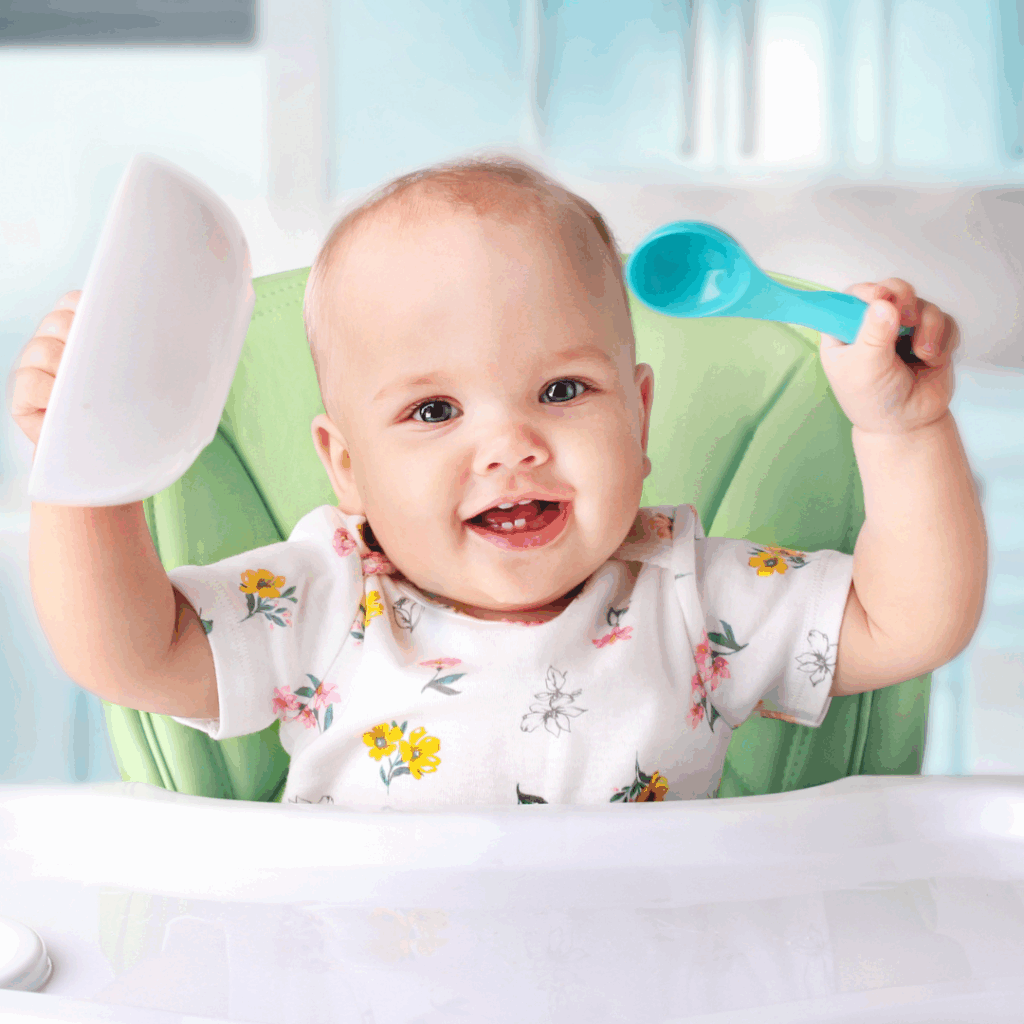
Fullness cues

Signs that your baby is full and has had enough of their meal include (7):
Stops opening their mouth for the spoon
Spitting out food
Getting distracted
Turning away from you or the food
Shaking their head “No”
Getting agitated or fussy
Whining
What this looks like in practice
You might be thinking to yourself, “How can I let my baby be in charge of the feeding process when I’m the one holding the spoon?”. Let’s go over step-by-step how to spoon-feed your baby purees in a responsive way.
Step 1:
Make sure that your baby is seated comfortably in their chair in an environment that is free of distractions. Then, sit down next to your baby so that you’re at eye level with them at an angle where they can see you.
Step 2:
Preload a baby-safe spoon with a small amount of puree, then bring the spoon a few inches away from your baby’s mouth.
Step 3:
Once your baby sees the spoon in front of them, wait for them to lean forward towards the spoon, open their mouth, and wrap their lips around the spoon.
Step 4:
Once the spoon is in your baby’s mouth, wait for your baby to make the first move! Keep the spoon still and hold it horizontally with your baby’s lips wrapped around it. Wait for your baby to initiate the motion of removing the food from the spoon.
Step 5:
Once they’ve removed the food, pull the spoon out of their mouth while keeping it in the same horizontal position.
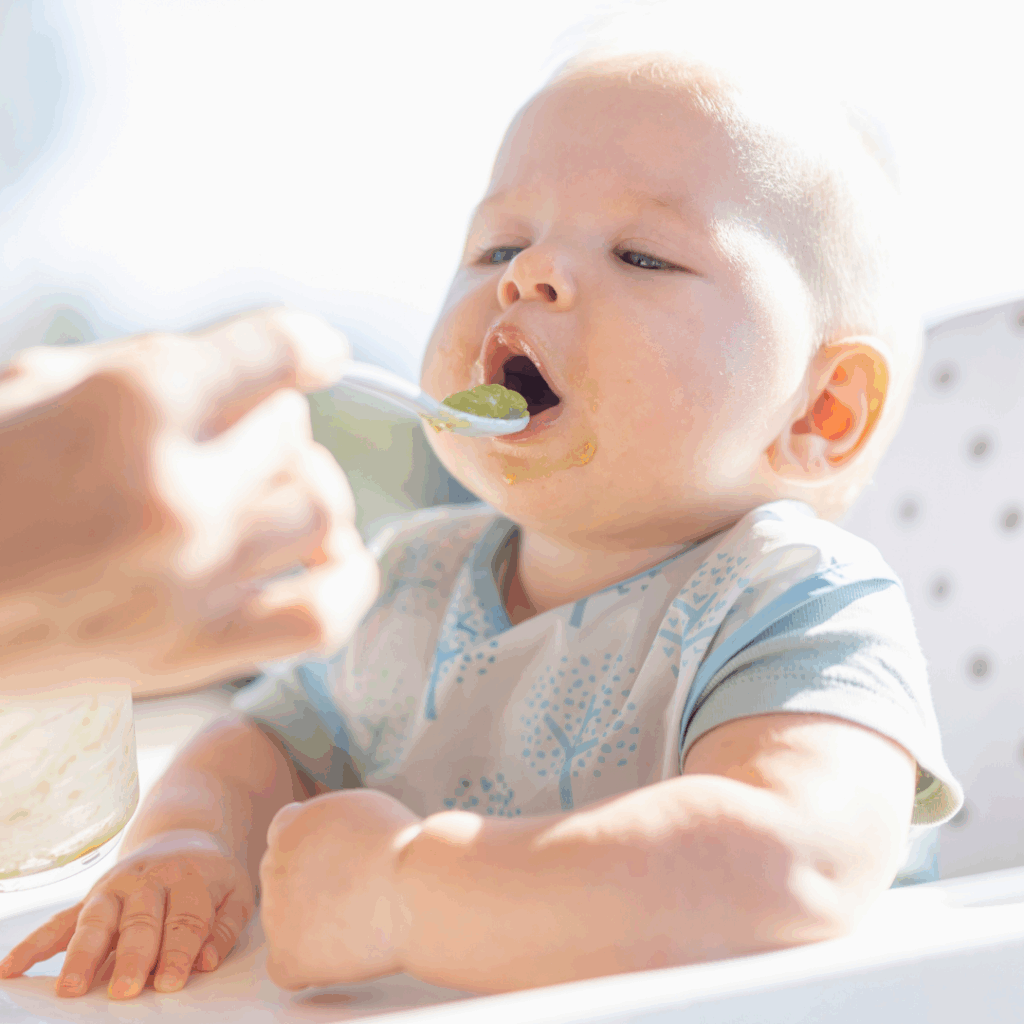
Cues that your baby wants to self-feed
There will come a time when your little one will start to show signs of wanting to feed themselves. This is a good thing!
It’s important to know what these cues look like so that you can take these moments as an opportunity to let your baby try flying solo!
Signs your baby may want to try feeding themselves more independently include:
Reaching or grabbing for the spoon
Putting their hand on top of yours
Reaching for food directly from their bowl or plate
Common mistakes to avoid when spoon-feeding purees
Even with the best intentions, it’s easy to make a few missteps when feeding your baby pureed food. Here’s what to watch for — and how to stay on track.
Force-feeding: We understand that it can be super stressful to feel like your baby isn’t eating enough, but we NEVER recommend force-feeding your baby. Force-feeding can create a negative association around food, not to mention disregard your little one’s hunger and fullness cues (which we really want to be looking out for and responding to!).
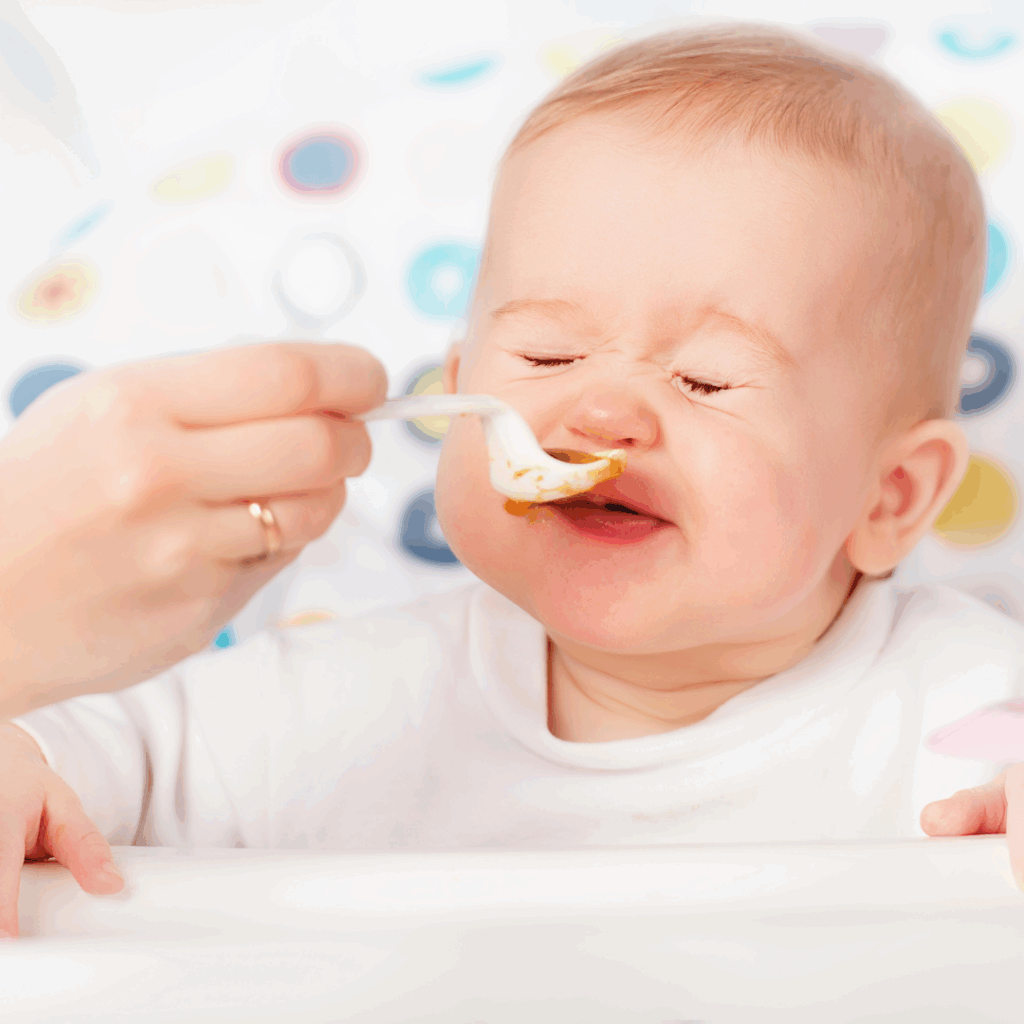
Tricking or distracting your baby: Trying to sneak bites into your baby’s mouth when they’re not paying attention (like turning their head or looking away) may seem harmless, but it’s risky — and can break trust. Not only does this increase the risk of choking (since your baby isn’t prepared to swallow), but it also teaches them that meal time isn’t a predictable, respectful experience. We always recommend waiting for your baby to actively open their mouth before offering a spoonful. That shows they’re physically and mentally ready for the bite — and reinforces safe, responsive eating.
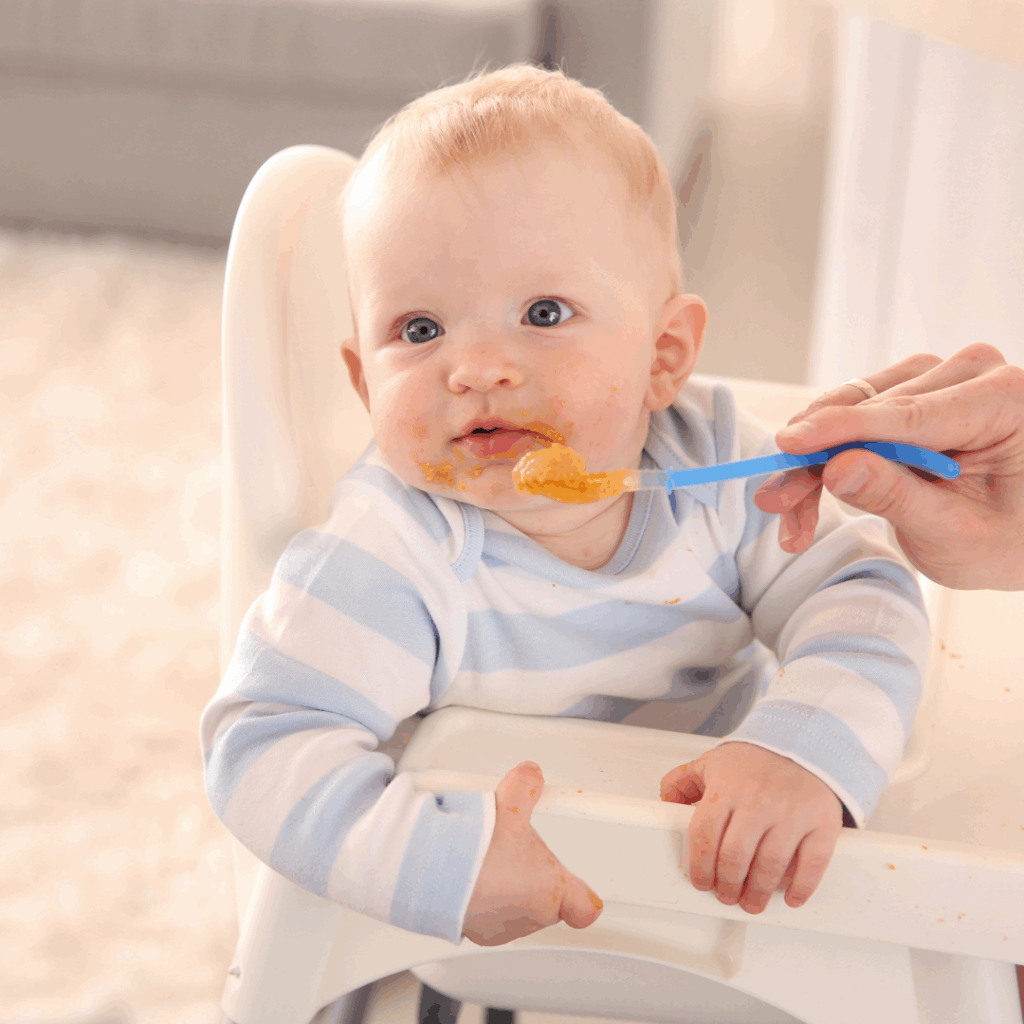
Wiping baby’s mouth with the spoon: Avoid the temptation to constantly use the spoon to wipe extra puree off of your baby’s face. Occasional cleanups are fine, but babies benefit from the sensory exposure that comes from feeling food on their skin. Texture on their cheeks and chin helps them get comfortable with the idea of mess — and with different food consistencies. This kind of exposure can help to prepare them for the experience of eating different foods and food textures as they move through more advanced meals. Try to embrace the glorious mess of your little one learning how to eat…this phase of eating won’t last forever!
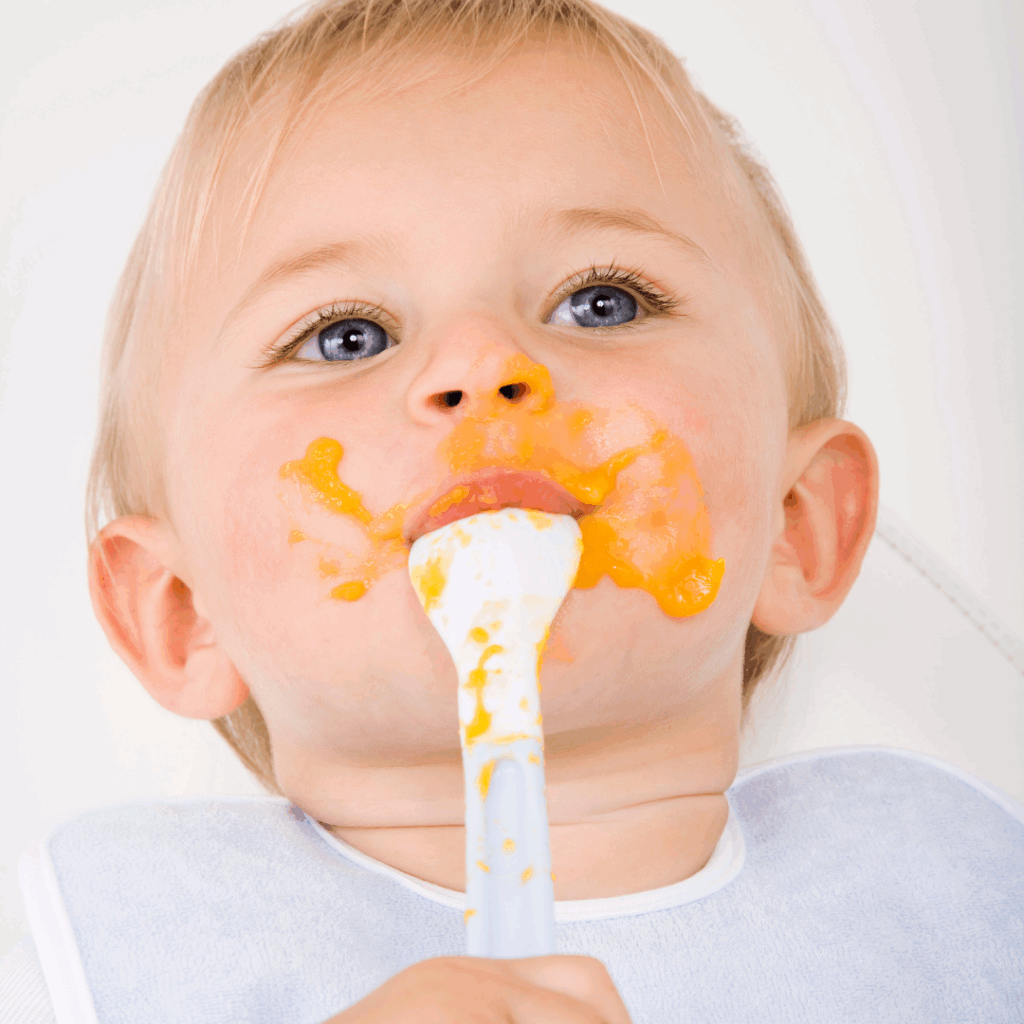
Overloading the spoon: It can be tempting to load up a spoon with as much puree as possible so that your baby gets a big bang for their bite. However, overloading the spoon can be overwhelming for your baby! It’s better to start small and only load a little bit of puree onto the spoon at a time so that your baby can take a bite that will be more manageable in their little mouth.
Feeding too quickly: Babies need time to explore each bite — even when it’s smooth pureed food. Feeding too fast can overwhelm them and make it hard for them to practice the tongue and jaw movements they’re still developing. While it’s fine to reload the spoon quickly, don’t rush each bite. Wait for your baby to open their mouth or lean forward to signal they’re ready. It’s important to keep all meals baby-led and go at your baby’s pace!

Not letting your baby try self-feeding: As soon as your baby shows interest in holding the spoon, dipping into food, or bringing it to their mouth, it’s time to start offering self-feeding opportunities — even if it’s messy. Letting your baby practice feeding themselves supports motor skill development, coordination, and independence. Yes, intake may drop for a while — and yes, some food will end up on the floor — but remember: breast milk or formula are still covering most of their nutritional needs. This is the window to build skills, not perfect mealtime volume. Start with pre-spoons like the NumNum Gootensil and thick pureed food that sticks well. Support their efforts, but resist the urge to “fix” things — practice is how they improve.

Staying stuck on purees for too long: Babies need to start exploring more complex textures (like mashed, lumpy, or soft finger foods) by around 8-9 months of age. Waiting too long to offer texture increases the risk of picky eating later in life. In fact, research shows that delaying the introduction of lumpier textures past 9 months is associated with increased feeding difficulties and more resistance to new foods in toddlerhood (9). This is why we recommend using pureed food as a stepping stone, not a long-term solution. Take advantage of the sensitive window between 6–9 months, when babies are most open to trying new textures and flavors (11). Our Texture Timeline™ can guide you step-by-step in advancing textures safely and confidently.
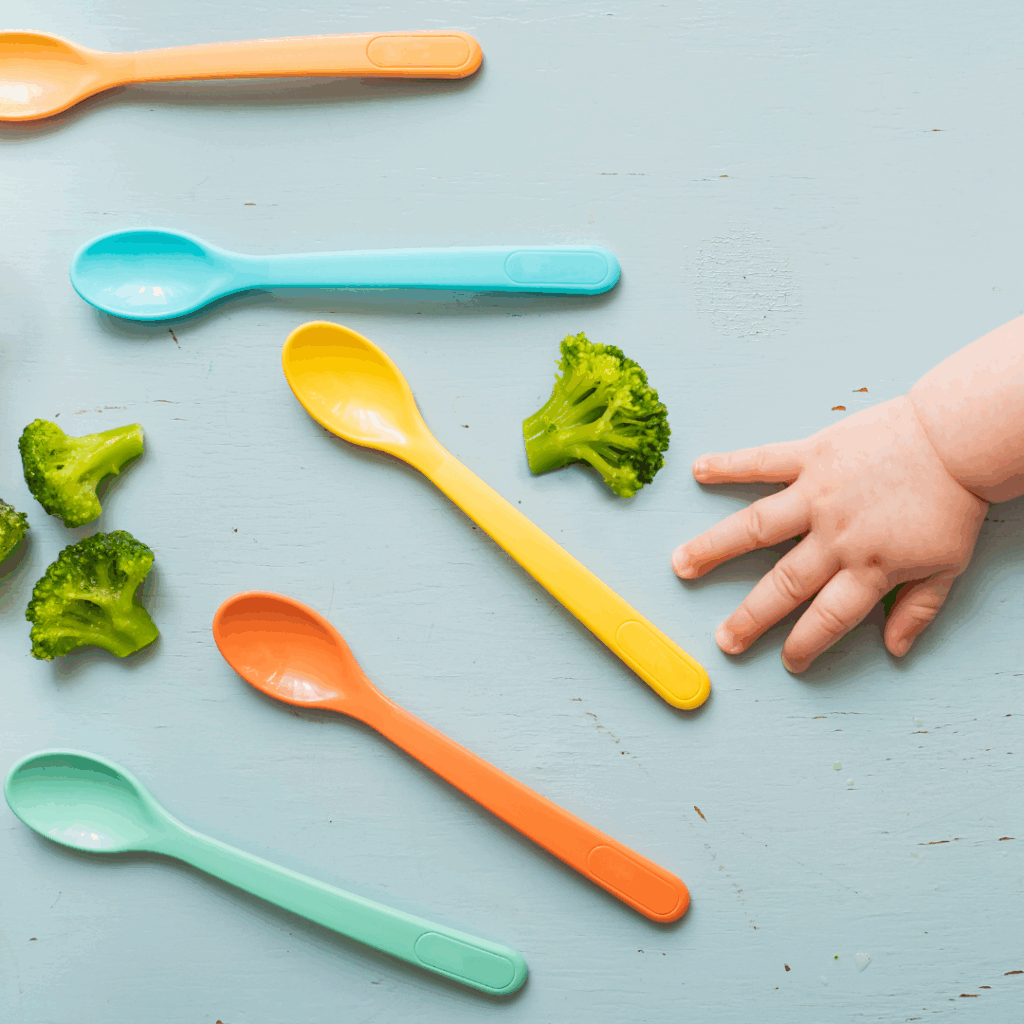
What are some good pureed foods to offer?
While you can start with completely smooth puree (phase 0 on the Texture Timeline™), we only recommend staying on thin and smooth textures for 1-5 days. Once your baby has shown they can swallow that texture phase with ease, move on and allow them to build skills in phase 1-3 of the Texture Timeline™. The right texture puree will depend on what stage they are working on mastering at the time.
Some examples of thicker, lumpier purees include:
Hummus (phase 1)
Full-fat Greek yogurt (phase 1)
Liver pâté (phase 1)
Boiled egg yolk, mashed (phase 1)
Small pasta like macaroni, mixed into marinara sauce (phase 2)
Oatmeal made with rolled oats (phase 2)
Mashed beans (can add chicken broth to bind it together a bit more) (phase 2)
Loose ground beef mixed in tomato sauce (phase 2)
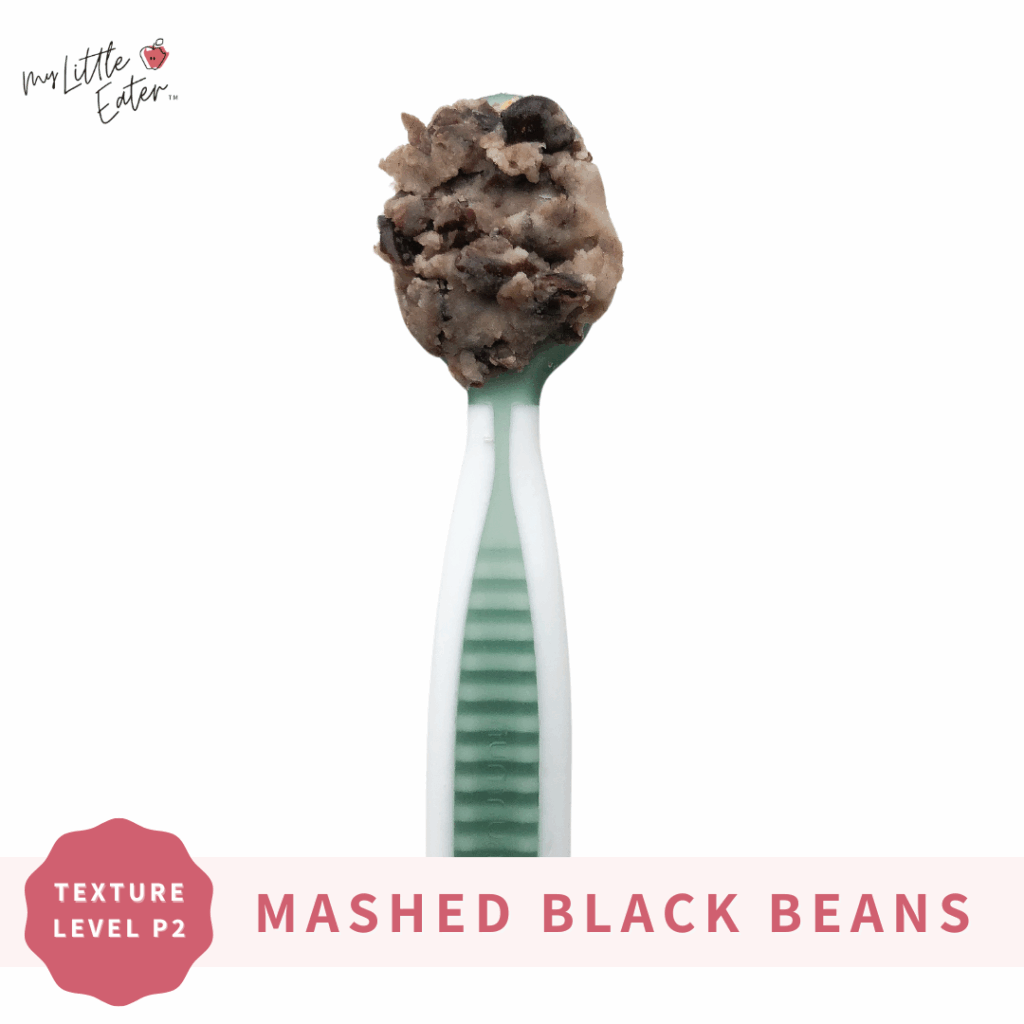
Best spoons for starting solids with purees
Choosing the right spoon can make a big difference when feeding your baby pureed food. With so many options out there, we’ve broken it down into three key stages of the puree-feeding journey: spoon-feeding, pre-spoons, and self-feeding.
Spoons for when you feed baby
In the beginning, you will be the one feeding your baby food, and so you’ll want a spoon with specific characteristics that make this easier.
What to look for:
Long handle for easy reach and control
Shallow, narrow bowl that fits your baby’s small mouth comfortably
Soft, baby-safe materials like BPA-free silicone
Avoid metal spoons at this stage — they’re hard, cold, and can easily bump your baby’s gums or lips, especially as they start reaching for the spoon.
Our top pick: OXO Tot Silicone Spoon Set
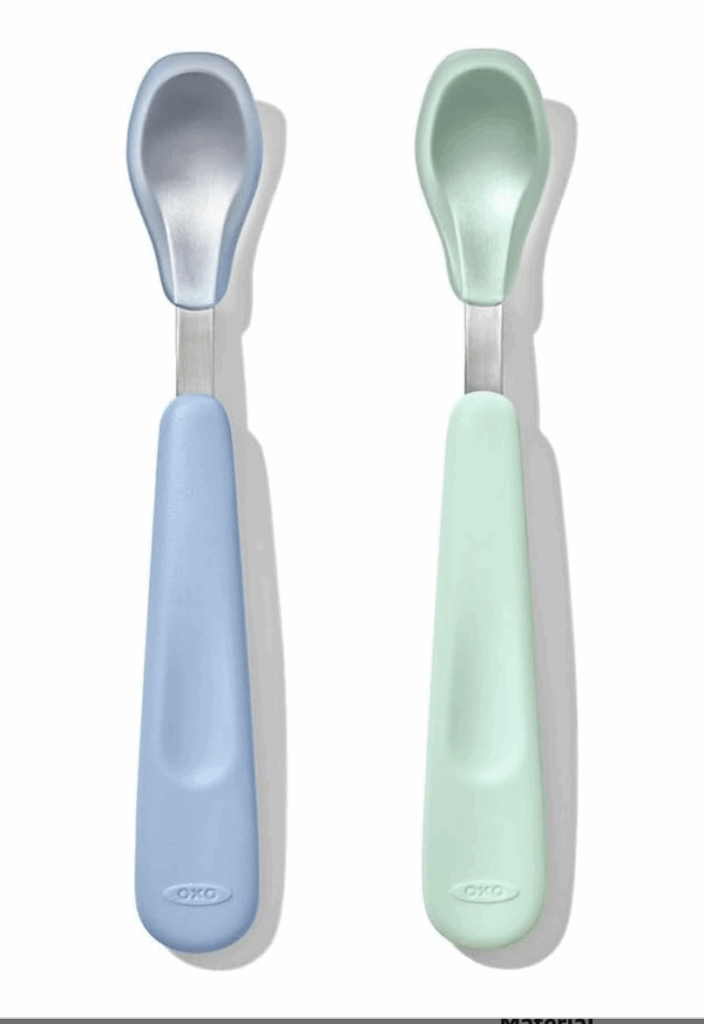
These long-handled spoons are perfectly shaped for first feedings. They have a more narrow and shallow “bowl” that fits easily into your baby’s mouth, and the soft silicone means no stress if there’s a little bump here or there. Plus, they’re dishwasher safe and durable enough to last through every phase of pureed food feeding.
Pre-Spoons: the best option from 6-9 months
Once your baby starts showing interest in holding the spoon, it’s time to introduce a pre-spoon — a tool designed to help them learn how to bring pureed food to their mouth without needing full scooping skills.
Why it helps:
Pre-spoons don’t require perfect wrist motion
Grooves or ridges trap pureed food, reducing drips and spills
Builds confidence in self-feeding without frustration
Our favorite: NumNum Gootensil
This genius little spoon is designed for beginners. Instead of scooping, your baby just dips it in — the ridged surface holds enough puree for them to bring to their mouth with minimal mess. It’s a game-changer for transitioning from spoon-feeding to self-feeding, especially for thicker purees like mashed sweet potato or lentils.
Spoons for more experienced eaters (9-12 months+)
Once your baby has become more experienced with using a pre-spoon and has practiced the scooping motion more, you can start to offer them a spoon with a true “bowl” on the end that requires a more advanced scooping motion to get and keep food on.
What to look for:
Short, chunky handle that’s easy to grip with a full fist (palmar grasp)
Soft materials to protect gums
At this stage, your baby is still working on fine motor skills — so skip anything too narrow or long.
Our go-to: Bumkins Chewtensil
This spoon has a wide, rounded handle that’s easy for babies to grab. It’s made from soft silicone and is perfectly shaped for early self-feeding. Whether they’re dipping it in applesauce or thick pureed vegetables, your baby gets to explore pureed food on their own terms.
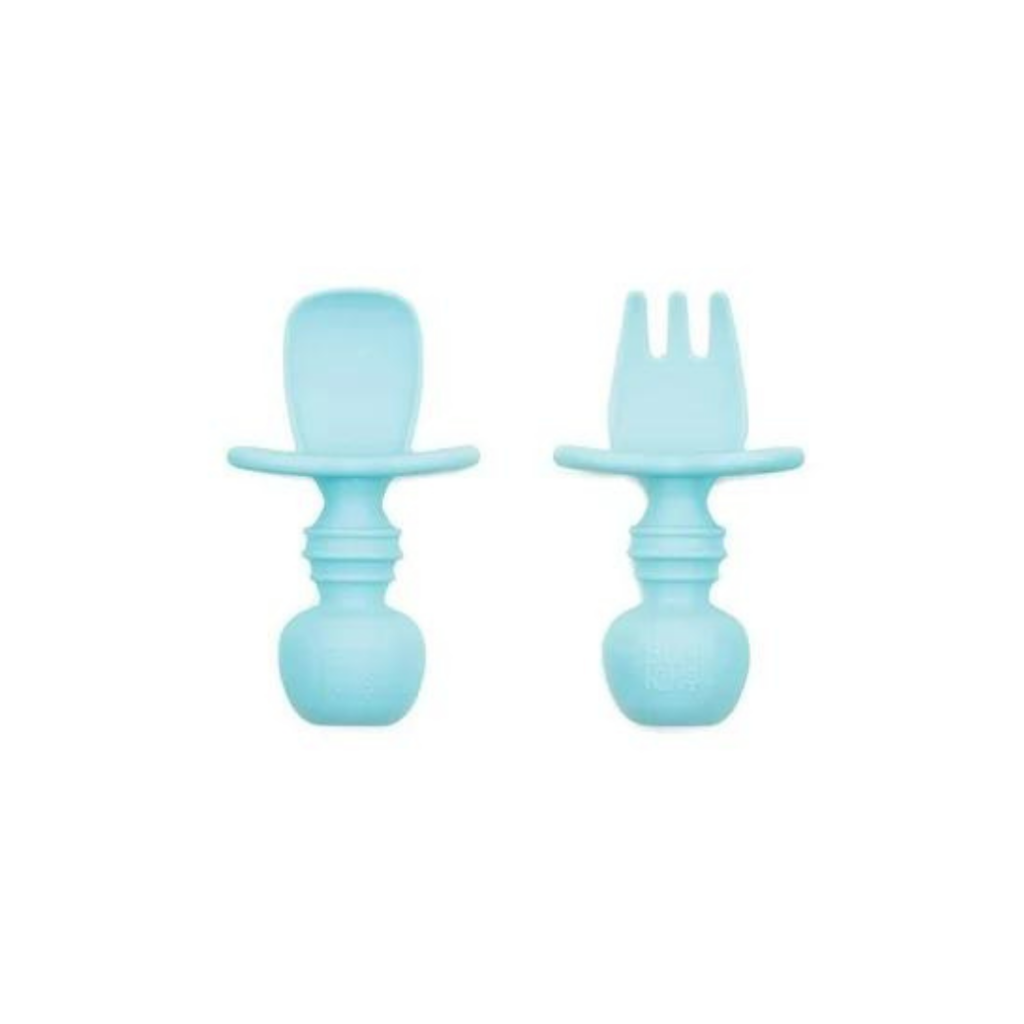

If you’re feeling overwhelmed about starting solids and you’re not sure where to begin, join our FREE workshop – How to start solids: A realistic first week of feeding your baby. This workshop is for parents ready to feel confident and prepared to start solids—without all the guesswork.
Learn exactly what to feed, when to feed it, and how to do it—step-by-step—with expert guidance from pediatric dietitian, Edwena Kennedy. Plus, get a FREE 5 day meal plan just for attending! Sign up here.
Pin & save these tips for how to spoon-feed baby!
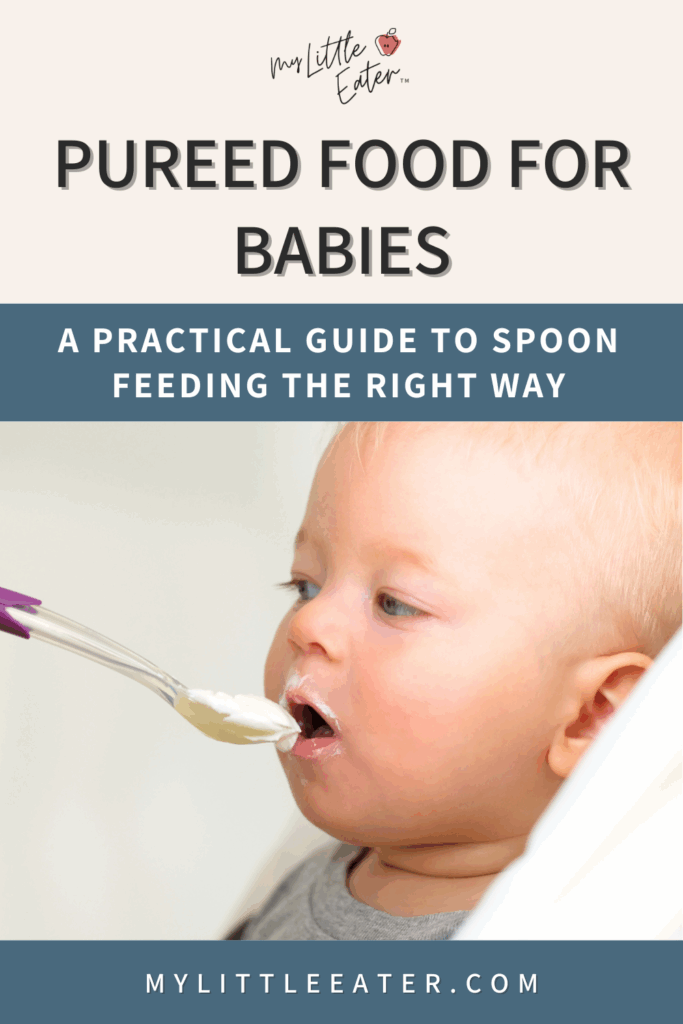
References
Black, M. M., & Aboud, F. E. (2011). Responsive feeding is embedded in a theoretical framework of responsive parenting. The Journal of nutrition, 141(3), 490–494. https://doi.org/10.3945/jn.110.129973
Ramsay, S. A., Branen, L. J., Fletcher, J., Price, E., Johnson, S. L., & Sigman-Grant, M. (2010). “Are you done?” Child care providers’ verbal communication at mealtimes that reinforce or hinder children’s internal cues of hunger and satiation. Journal of nutrition education and behavior, 42(4), 265–270. https://doi.org/10.1016/j.jneb.2009.07.002
Kral, T. V., Stunkard, A. J., Berkowitz, R. I., Stallings, V. A., Brown, D. D., & Faith, M. S. (2007). Daily food intake in relation to dietary energy density in the free-living environment: a prospective analysis of children born at different risk of obesity. The American journal of clinical nutrition, 86(1), 41–47. https://doi.org/10.1093/ajcn/86.1.41
Perez-Escamilla, R., Segura-Pérez, S., & Lott, M. (2017). Feeding guidelines for infants and young toddlers: a responsive parenting approach. Nutrition Today, 52(5), 223-231.
DiSantis, K. I., Hodges, E. A., Johnson, S. L., & Fisher, J. O. (2011). The role of responsive feeding in overweight during infancy and toddlerhood: a systematic review. International journal of obesity (2005), 35(4), 480–492. https://doi.org/10.1038/ijo.2011.3
McNally, J., Hugh-Jones, S., Caton, S., Vereijken, C., Weenen, H., & Hetherington, M. (2016). Communicating hunger and satiation in the first 2 years of life: a systematic review. Maternal & child nutrition, 12(2), 205–228. https://doi.org/10.1111/mcn.12230
Hodges, E. A., Johnson, S. L., Hughes, S. O., Hopkinson, J. M., Butte, N. F., & Fisher, J. O. (2013). Development of the responsiveness to child feeding cues scale. Appetite, 65, 210–219. https://doi.org/10.1016/j.appet.2013.02.010
Fangupo, L. J., Heath, A. M., Williams, S. M., Erickson Williams, L. W., Morison, B. J., Fleming, E. A., Taylor, B. J., Wheeler, B. J., & Taylor, R. W. (2016). A Baby-Led Approach to Eating Solids and Risk of Choking. Pediatrics, 138(4), e20160772. https://doi.org/10.1542/peds.2016-0772
Coulthard, H., Harris, G., & Emmett, P. (2009). Delayed introduction of lumpy foods to children during the complementary feeding period affects child’s food acceptance and feeding at 7 years of age. Maternal & child nutrition, 5(1), 75–85. https://doi.org/10.1111/j.1740-8709.2008.00153.x
World Health Organization. (2016). Complementary feeding. Retrieved from: http://www.who.int/nutrition/topics/complementary_feeding/en/
Harris, G., & Mason, S. (2017). Are There Sensitive Periods for Food Acceptance in Infancy?. Current nutrition reports, 6(2), 190–196. https://doi.org/10.1007/s13668-017-0203-0
Cameron, S. L., Heath, A. L., & Taylor, R. W. (2012). How feasible is Baby-led Weaning as an approach to infant feeding? A review of the evidence. Nutrients, 4(11), 1575–1609. https://doi.org/10.3390/nu4111575
Rapley, G., & Murkett, T. (2019). Baby-led weaning: Helping your baby to love good food. Vermilion.
Brown, A., & Lee, M. D. (2015). Early influences on child satiety-responsiveness: the role of weaning style. Pediatric obesity, 10(1), 57–66. https://doi.org/10.1111/j.2047-6310.2013.00207.x
Cichero, J. A. (2016). Introducing solid foods using baby‐led weaning vs. spoon‐feeding: A focus on oral development, nutrient intake and quality of research to bring balance to the debate. Nutrition Bulletin, 41(1), 72–77. https://doi.org/10.1111/nbu.12191
van den Engel-Hoek, L., van Hulst, K. C., van Gerven, M. H., van Haaften, L., & de Groot, S. A. (2014). Development of oral motor behavior related to the skill assisted spoon feeding. Infant behavior & development, 37(2), 187–191. https://doi.org/10.1016/j.infbeh.2014.01.008
Delaney, A. L., & Arvedson, J. C. (2008). Development of swallowing and feeding: prenatal through first year of life. Developmental disabilities research reviews, 14(2), 105–117. https://doi.org/10.1002/ddrr.16
Centers for Disease Control and Prevention (CDC). (2021). Fingers, Spoons, Forks, and Cups. https://www.cdc.gov/nutrition/infantandtoddlernutrition/mealtime/fingers-spoons-forks-cups.html
Gerber, R. J., Wilks, T., & Erdie-Lalena, C. (2010). Developmental milestones: motor development. Pediatrics in review, 31(7), 267–277. https://doi.org/10.1542/pir.31-7-267

Edwena Kennedy, RD
Founder and lead Registered Pediatric Dietitian at My Little Eater Inc., creator of The Texture Timeline™, and mom of two picky-turned-adventurous eaters.

Edwena Kennedy, RD
Founder and lead Registered Pediatric Dietitian at My Little Eater Inc., creator of The Texture Timeline™, and mom of two picky-turned-adventurous eaters.
